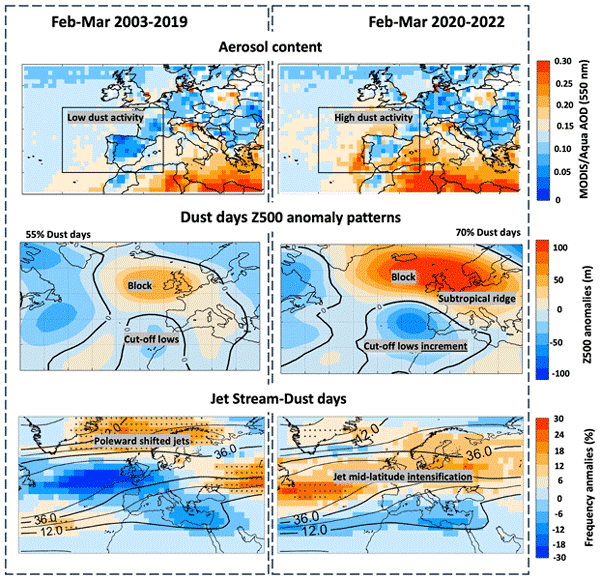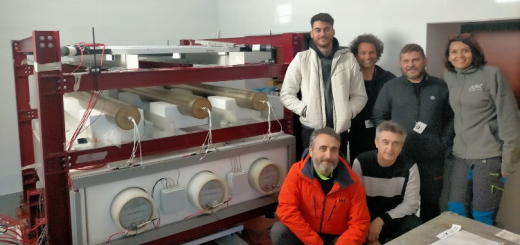“Sharp increase in Saharan dust intrusions over the western Euro-Mediterranean in February–March 2020–2022 and associated atmospheric circulation” has been published in Atmospheric Chemistry and Physics.
Clic here for spanish version

Figure. MODIS/Aqua Aerosol Optical Depth at 550 nm (top panels), main clusters of Z500 anomalies (in m; middle panels) and jet stream frequency anomaly (in %; bottom panels) for the winter (February-March) dust days of the 2002–2019 (left) and 2020–2022 period (right). The black box in the top panels delimits the WEM spatial domain (i.e. 35–50° N, 20° W–5° E). The middle panels include the relative frequency of dust days in each cluster. Anomalies (colour shading) of the jet frequency in the bottom panels are defined with respect to the expected frequency of occurrence (contours), with dots denoting significant positive anomalies (p < 0.05)
This study describes the unusual frequency, intensity, and persistence of the dust storms that hit the western Euro-Mediterranean (WEM) in February-March (FM) 2020-2022, including the associated synoptic and large-scale atmospheric patterns. Before this period, the occurrence of winter dust intrusions in WEM was very small and irregular, being common to observe periods of several consecutive years without any dust intrusion. Using dust products from satellites (available since 2003) and atmospheric aerosol reanalysis, this study demonstrates that the winters (February-March) of 2020-2022 over WEM were exceptional in terms of African dust intrusions in comparison with 2003-2019. For the historical winter records of 2003-2019 more than half of all winter dust events over WEM were accompanied by cut-off lows between the Canary Islands and the Iberian Peninsula, which is substantially higher than the frequencies for central and eastern Mediterranean events reported in the literature. These cut-off lows are forced to move towards the subtropical region due to the presence of blocking highs over the mid-latitudes of the Euro-Atlantic sector and the associated poleward jet configuration. During the anomalous dusty winter period of 2020-2022, intense dust events occurred under enhanced mid-latitude blocking and poleward jet configurations, or under high-pressure structures at subtropical ridges, which favour a mid-latitude intensification of the jet rather than its poleward migration, as shown in the key-figure.
The study makes a step forward towards the full understanding of winter dust events in WEM and their atmospheric drivers, which have been poorly assessed so far. This is particularly relevant considering the relatively high frequency of dust events during the last winters, and the associated impacts in air quality. Indeed, in the winters of 2023 and 2024, there have been two WEM dust intrusions that meet the requirements of “strong” events established in the study: 18-22 February 2023 and 19-23 March 2024. In both cases, a cut-off low between the Canary Islands and the Iberian Peninsula was accompanied by high-pressure systems at subtropical ridges, which corresponds to the atmospheric patterns described in the paper during the period of high dust activity (2020-2022). The final version of the article is available at:
For more details about this work please refer to:
Cuevas-Agulló, E., Barriopedro, D., García, R. D., Alonso-Pérez, S., González-Alemán, J. J., Werner, E., Suárez, D., Bustos, J. J., García-Castrillo, G., García, O., Barreto, Á., and Basart, S.: Sharp increase in Saharan dust intrusions over the western Euro-Mediterranean in February–March 2020–2022 and associated atmospheric circulation, Atmos. Chem. Phys., 24, 4083–4104, https://doi.org/10.5194/acp-24-4083-2024, 2024.







